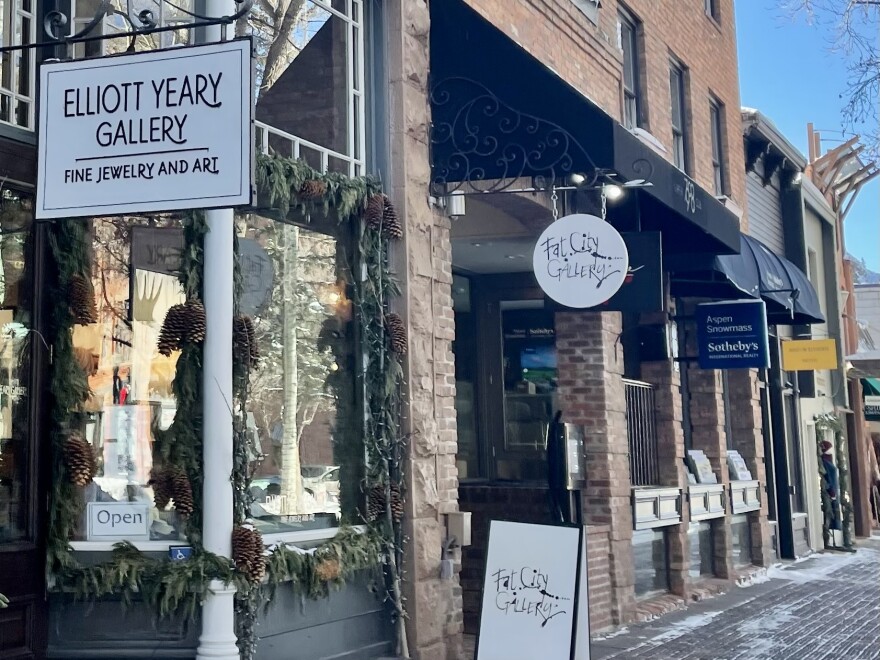The latest iteration of Aspen’s Fat City Gallery is barely more than two doorways wide, sandwiching historical maps of Aspen and silkscreen prints from poster artist and activist Thomas W. Benton between a real estate office and another art gallery on the East Hyman Avenue pedestrian mall in downtown Aspen.
Fat City Gallery Director D.J. Watkins calls the space a “glorified hallway.”
And at the opening party for the new location on Saturday, it was packed. Artists, environmentalists, collectors and so-called Aspen “characters” filled every corner of the space to celebrate the return of Fat City Gallery and appreciate the 20-odd Benton works on the walls that meld poetry with smooth graphics and community history.
“I like how [Fat City Gallery] keeps that, what we might call the ‘freak spirit’ alive in Aspen,” said Eric Ringsby, who has long ties to Aspen and a history acquiring art from Watkins.
His family has roots in the Roaring Fork Valley three generations deep, and he appreciates the way Benton’s posters remind him of the Aspen of his youth in the 1970s, but he’s not one to love solely in the past.
“I think you can make a lot of jokes about old Aspen and old Aspenites [who say] ‘It was always better in the past,’” Ringsby said at the opening party. “I think it is a mistake to think it was always better in the past, and it's wonderful today.”
Like Ringsby, Watkins likes to see some good in the present, too. The Fat City opening on Saturday night was the just the latest in a decade-long history of the countercultural community hub formerly known as the Gonzo Gallery; the last version of “Fat City,” located on East Cooper Avenue, closed in 2021.
“When I had the opportunity to move in here, I thought, you know, this will be a wonderful thing, being on the Hyman Avenue Mall and being able to be in the center of things, but also to create a space for our friends and locals and the characters that are maybe left over from previous iterations of Aspen,” Watkins said in an interview on Feb. 7.

The gallery and its community have hopscotched Aspen addresses since Watkins ran the “Gonzo Museum” from 2012 to 2013 in a space that previously served as Tom Benton’s studio on East Hyman Avenue. That first iteration was named for gonzo journalist Hunter S. Thompson; there, Watkins showed works by artists like Benton, Thompson, illustrator Ralph Steadman and Beat Generation writer and artist William S. Burroughs.
It laid the groundwork for several later versions of the Gonzo Gallery at several different locations, where Watkins hosted intellectual conversations and events and showcased artworks from the 1960s and ‘70s as well as modern exhibitions by artists like Ajax Axe and Michael Cleverly.
Watkins renamed the gallery “Fat City” with one of his location changes in 2021 in an effort to broaden the horizons of the gallery while still honoring its origins; the new name is a reference to Thompson’s 1970 campaign promise to rename Aspen “Fat City” if he was elected Pitkin County sheriff.
“I've been lucky to show all sorts of incredible artists,” Watkins said. “Over the years we've curated over 50 exhibits over time. …we're going to keep it active and fresh and interesting, but always Fat City.”
Through nearly half a dozen new location openings and almost as many closings and at least a few end-of-an-eras that weren’t actually the end of the era, Watkins has always managed to find another nook or cranny in town where he could strike a rent bargain and show art from Aspen’s past and present.
That, too, has Watkins acknowledging his good fortune.
“I've been really lucky to have opportunities in town to kind of keep things going and show engaging local historical art, and there's a lot of talk in the community of things changing,” Watkins said. “I'm an optimist. I like to think that Aspen has changed probably more than most places. And we're back in a new location and having fun and showing art and bringing the community together, and that feels good.”

Watkins credits Ross Kribbs, the owner of the former Nugget Gallery, for first turning this “glorified hallway” into a space to showcase local art about a decade ago.
“It was an informal space that was kind of legitimized, and it's actually pretty large, but it's not your traditional brick and mortar retail store. … The focus is going to be on events, exhibitions, openings, talks, and to try to bring life into the space,” Watkins said.
At that opening party over the weekend, there was no question about the liveliness of the gallery.
But there was one notable absence: former Pitkin County Sheriff Bob Braudis, who died last June at the age of 77. The “Freak Power” sheriff and so-called “gentle giant” was close friends with Watkins and a fixture at gallery events in the past.
“We all miss him terribly, but you know, we're going to do our best to honor him,” he said. “And, you know, he's here in all our hearts, so I think he'd be proud to know that we're posted up on the mall, and I think we'll definitely do our best to honor his legacy and vision and keep him close to us, even though he's not here.”
The new space is open by appointment, with more events to come in the future.







